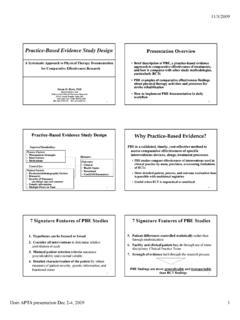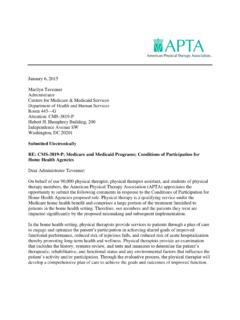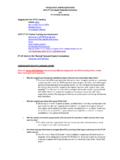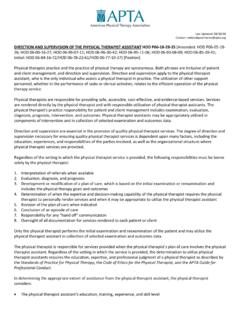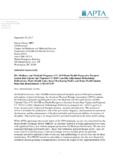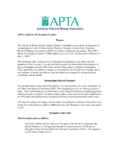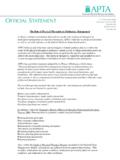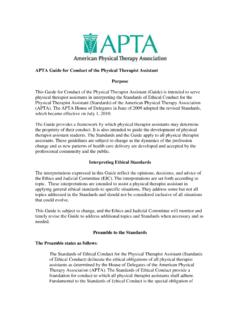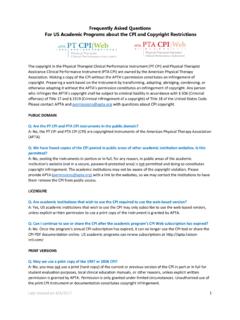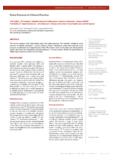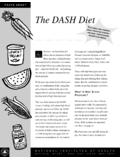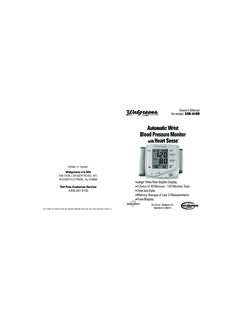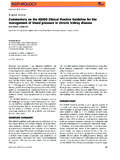Transcription of Lab Values – Limitations for Exercise And Physical Activity
1 Medications Affecting Responses To Exercise or Physical Activity2 Beta Blockersblunts heart rate and blood pressure responsesCalcium Channel Blockersdecreases resting and Exercise blood pres-sure response; may cause reflex tachycardia, edema, and/or post- Exercise hypotensionDigitalismay cause dysrhythmias and/or tachycardiaBronchodilatorsmay increase heart rate and blood pressure ; may cause dysrhythmias (if non-selective agonist)Diureticsmay cause dysrhythmias; may cause fluid depletion or dehydrationVasodilatorsmay increase risk of post- Exercise hypotensionPhysical Fitness for Survivors of StrokeNeurology and Cardiovascular & Pulmonary Sections of the American Physical Therapy Association in partnership with the American Physical Therapy Association1111 N Fairfax St, Alexandria, VA Values Limitations for Exercise And Physical Activity * blood Glucose100 250 mg/dL< 100 or >250 limited Activity Platelet Count< 60,000/mm3no resistive Exercise < 20,000/mm3 AROM, maybe walking< 5,000/mm3 no Activity CoumadinProtime (PT) or INR > 3no exerciseUnfractionated HeparinPartial Thromblastin Time (PTT) > 3x normal range valueno exerciseHemoatocrit (%)/Hemoglobin (g/dL)
2 = 30%/10 g/dLreduced Exercise capacitybetween 24 30%/8 10 g/dLmarkedly reduced Exercise capacity< 24%/< 8 g/dLno Exercise *Expert consensusSupplement to PT Magazine October 2006 Additional information is available at document is not intended for use as a patient/client Affecting Responses To Exercise or Physical Activity2 Beta Blockersblunts heart rate and blood pressure responsesCalcium Channel Blockersdecreases resting and Exercise blood pres-sure response; may cause reflex tachycardia, edema, and/or post- Exercise hypotensionDigitalismay cause dysrhythmias and/or tachycardiaBronchodilatorsmay increase heart rate and blood pressure ; may cause dysrhythmias (if non-selective agonist)Diureticsmay cause dysrhythmias; may cause fluid depletion or dehydrationVasodilatorsmay increase risk of post- Exercise hypotensionTarget Heart Rate Range Graded Exercise Test Performed 50 80% of maximal heart rate achievedNo Graded Exercise Test Performed40 70% of predicted maximal heart rate (220-age)Formulas for estimating heart rate are inaccurate in individuals using beta blockers or calcium channel block-ers.
3 Lower target heart rates may be indicated. For these individuals, the Borg Rating of Perceived Exertion CR 10 (RPE) may be a better indicator of individual work level. Selection of RPE target should include consideration of individual s current fitness level and Exercise Borg CR10 Range: 3 (Moderate) 4 using this scale. If using the 6 20 scale, Target Borg Range: 11 (Light) Exercise Training Intensity Guidelines for Stroke Survivors1 Post-strokePhysical Fitness for Survivors of Stroke Based on Best Available Evidence Borg CR10 Scale Gunnar Borg 1982, 1998 Borg CR10 Scale 0 Nothing at all Extremely weak Just noticeable 1 Very weak 2 Weak Light 3 Moderate 4 5 Strong Heavy 6 7 Very strong 8 9 10 Extremely strong Maximal 11 Absolute maximum Highest possibleImportant Things to Know2, 3 10 15% of individuals s/p CVA may have silent ischemia.
4 Individuals with diabetes are more often prone to silent isch-emia, postural hypotension, and/or blunted heart rate response. DVT complications have been reported in 30 75% of stroke survivors. 3 5% of people > 65 years old have atrial fibrillation; ~ 15% of strokes occur in individuals with atrial HR> 100 bpm or < 50 bpm SignsResting SBP> 200 mmHg or < 90 mmHgResting DBP> 110 mmHg Oxygen Saturation< 90% Othercyanosis, diaphoresis, bilateral edema in a patient with CHF, pallor, fever, weight gain > 4 6 lbs/day, abnormal change in breath sounds or heart soundsSymptomsSOB, angina, dizziness, severe head-ache, sudden onset of numbness or weakness, painful calf suggestive of DVTC ontraindications for Exercise Or Physical Activity4, 5 HRsudden drop > 15 bpm, change from regular to irregular rhythm, or exceeds HR maximum Signs SBP> 200 mmHg, decreases to < 90 mmHg, drop > 10 mmHg from resting or with increasing Exercise DBP> 110 mmHgOxygen Saturation< 90%Othercyanosis, diaphoresis, bilateral edema in a patient with CHF, pallor, abnormal change in breath sounds or heart sounds, ataxiaSymptomsSOB.
5 Angina, dizziness, severe head-ache, sudden onset of numbness or weaknessIndications to Terminate Exercise Or Physical Activity4, 5 When to Monitor Physiologic Responses To Exercise and Physical Activity2 History of cardiac disease, valve dysfunction, angina, AND/OR other cardiac or pulmonary event. Presence of 2 or more risk factors for cardiac disease (eg, smoking, hypertension, dyslipidemia, diabetes, obesity, stress, sedentary lifestyle, family history significant for cardiac disease, age: men 45, women 55). Any change in medication regimen. Report of new symptoms. Progression of Exercise program in patient with 2 or more risk factors AND/OR previous cardiac or pulmonary events AND/OR low functional Gordon NF, Gulanick M, Costa F, Fletcher G, Franklin BA, Roth EJ, Sheph-ard T. AHA Scientific Statement: Physical Activity and Exercise Recom-mendations for Stroke Survivors.
6 Circulation. 2004; 109 American Heart Association American Stroke Association American College of Sports Medicine. ACSM s Guidelines for Exercise Testing and Prescription: 7th edition. Lippincott Williams 2005. 5 Fletcher BJ et al. Cardiac precautions for non-acute inpatient setting. Am J Phys Med Rehabil. 1993; 72:140 of Chest Pain Described as pressure , tightness, heaviness, sharp pain, a squeezing sensation and/or indigestion. Usually located in chest; may radiate to neck, jaw, mid-scapular region, and/or arms; may also occur in isolation in these regions. Symptoms may occur with exertion or emotional situations. Relieved with rest or nitroglycerine. Women present with atypical chest pain more frequently than men; symptoms may include neck/shoulder pain, nau-sea, vomiting, fatigue, dyspnea with or without chest pain. Chest pain that is reproducible with palpation is likely to be musculoskeletal in Scale4 Rating Description of pain /discomfort intensity1+ Light, barely noticeable2+ Moderate, bothersome3+ Severe, very uncomfortable4+ Most severe pain ever experiencedAssessment of Shortness of Breath Exercise produces a disproportionate ventilatory response AND/OR sensation of dyspnea.
7 Upper extremity Exercise is more likely to cause SOB in patients with compromised pulmonary status. Observe use of accessory muscles, pallor. Assess oxygen saturation. Patient may complain of (or present with) orthopnea, par-oxysmal nocturnal dyspnea, altered respiratory patterns (eg, Cheyne-Stokes respiration, paradoxical breathing).Dyspnea ScaleMahler, D A et al. J Appl Physiol. 2001; 90:2188 2196. Used with permission. 0 Nothing at all Very, very slight Just noticeable 1 Very slight 2 Slight Light 3 Moderate 4 Somewhat severe 5 Severe Heavy 6 7 Very severe 8 9 10 Very, very severe Almost maximum Maximal
